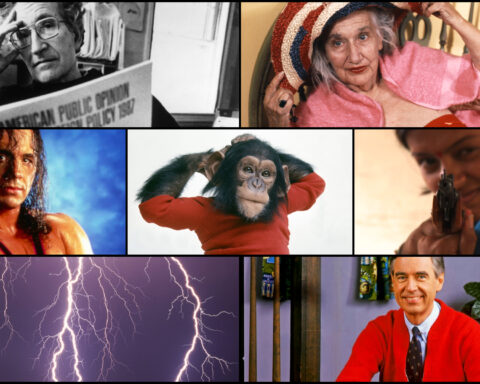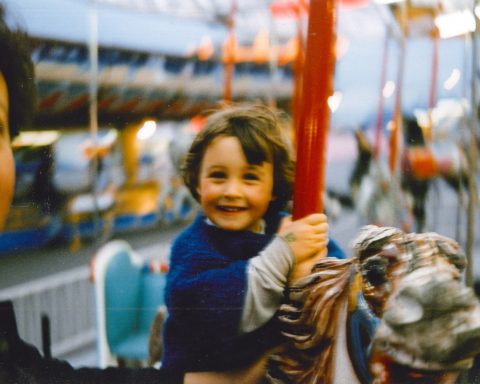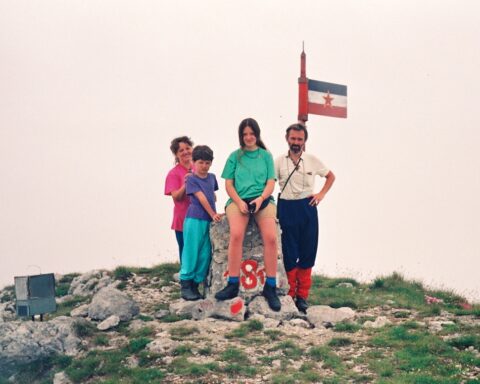The 26th edition of the International Documentary Festival Amsterdam took place in November, 2013. More than 280 films, 2600 professional guests and a record number of 222,000 audience members attended.
Some of the highlights? A programme comparing fiction films and docs based on the same story. New projects and ideas on digital storytelling @ IDFA DocLab. And a special Award in honor of Peter Wintonick.
Every year in November the International Documentary Festival Amsterdam (IDFA) transforms the blustery, rainy city into a hot spot for watching documentaries, discussing trends and networking. The festival has different venues scattered around the city, from the spectacular 92-year-old art deco Tuschinski cinema located in the heart of Amsterdam, to the Flemish Cultural Institute and the new iconic EYE Film Institute building.
Canada had 13 entries in the festival. Among them were: Ariel (dir. Laura Bari), Father Figures (dir. April Butler) and Forest of the Dancing Spirits (dir. Linda Västrik) took part in the IDFA First Appearance competition. New digital projects like Fort McMoney (dir. David Dufresne) and A Short History of the Highrise (dir. Katerina Cizek) competed for the IDFA DocLab Award for Digital Storytelling. Part of the Best of Fests programme, The Ghosts in Our Machine (dir. Liz Marshall) moved the audiences with a sensitive portrayal of photographer Jo-Anne McArthur’s work with animals.
For more on The Ghosts in Our Machine, read our profile of filmmaker Liz Marshall.
Reality Beats Fiction: Based on the Same Story
Every year, IDFA hosts a number of non-competitive programmes. Based on the Same Story, unique to this year’s edition, was organised in collaboration with the EYE Film Institute Nederland at their newly opened eye-shaped venue in Amsterdam North. The programme put back-to-back documentaries and fiction films based on the same subject. Following the screenings, American film critic Nicolas Rapold discussed with such filmmakers as Kevin McDonald and Todd Haynes their different approaches and processes of capturing history.
For example Manhunt (dir. Greg Barker, 2013) was coupled with its fiction counterpart, the Oscar winner film Zero Dark Thirty (dir. Kathryn Bigelow, 2012). Both films tell the story of capturing Osama Bin Laden, but the way they tell it is very different.
The work on the two films began quite at the same time. “I had the idea for the documentary the night of the Bin Laden raid,” said Greg Barker while introducing the film. “I was very uncomfortable with the cheering outside the White House, only because I knew there was a very dark story behind it,” he added. Barker set out to make a film that explores the story from the inside out, a spy movie both enjoyable and uncomfortable. And that’s precisely what he did.
Manhunt tells the story through the eyes of the people who worked for many years on the puzzles that led to the capturing of Osama Bin Laden in his hideout in Abbottabad, Pakistan. The film is alert and often challenging but also has moments of warmth and empathy. Besides fostering an understanding of Al-Qaeda’s development over the last 20 years, it also breaks down the stereotypical image of a CIA officer. If you had met the women featured in Manhunt, you would probably have never guessed that they worked for the CIA.
Once you’ve seen Manhunt, it is difficult to watch Zero Dark Thirty without noticing its fictional feel. The close parallel between the films underlines that fiction cannot beat reality—not when reality is well portrayed. While Manhunt focuses on the team behind the quest, Zero Dark Thirty is centered around Maya, a fictional construct based mainly on an intelligence officer the filmmakers got to know during their research. In Barker’s opinion, Maya’s role has been extrapolated because the team only had access to her. She was actually trained by women like the ones featured in Manhunt and was involved in the hunt for Bin Laden only in the last months before his capturing.
Zero Dark Thirty also distorts the image of Jennifer Matthews, the senior CIA officer who was killed in a bomb attack in Pakistan by a man who was thought to be a CIA informer but came to the base wearing a suicide vest. In the film she is far from the strong, intelligent and sharp woman her colleagues talk about in Manhunt. Her death was the effect of a chain of bad decisions, but Zero Dark Thirty ignores that chain and for the sake of the kind of simplification often seen in Hollywood, it makes her seem too enthusiastic and slightly naïve.
While Zero Dark Thirty is well acted and convincing, it sacrifices accuracy for the sake of telling a good story. The question is just how much can fiction films influence our perception and memory of real events?
Of course documentaries have their weak spots as well. Certain moments are not accessible for a director, a gap that fiction can easily fill in. “This is one of the values of a narrative…We could obviously never capture something like that in a documentary,” said Barker referring to the Zero Dark Thirty scene portraying a daily CIA meeting.
Barker is not the only one to acknowledge lack of access to place and people as a problem in making a documentary film. “I guess in fiction you can get inside people’s heads in a different and often better way than you can in non-fiction,” says director Kevin McDonald in an interview for IDFA’s magazine. “In documentary, you are usually exterior – you are usually reliant on following people around like a fly, a nuisance, or you’re reliant on interviews or archive. The thing about fiction is that you can have the pretense of being in people’s lives at the most crucial and intimate moments-–it’s very rare to be able to get that in documentary.”
The pretense of being in people’s lives is attractive and entertaining. But is it good enough to understand history? The Last King of Scotland, McDonald’s fiction film about Uganda’s dictator Idi Amin was screened together with the classic documentary General Idi Amin Dada, directed by Barbet Schroeder but heavily influenced by the dictator, who regarded it as “self portrait.”
The two films are very different. The Last King of Scotland portrays the General Idi Amin Dada’s darkest side, which could only shown by inference in Schroeder’s film. “In the documentary he comes across as stupid, and in The Last King of Scotland he is not stupid; he’s a much more complex and interesting character,” said McDonald after the screening. The Last King of Scotland is based on real events, but in the end it is an interpretation of the general’s personality.
In the documentary, Idi Amin Dada had no intention of showing his dark side or his weak spots. General Idi Amin Dada is all about his idea of how he wanted people to see him: he is a showman and enjoys the spotlight. Despite Schroeder’s agreement to allow Amin editorial control, the documentary is insightful. The camera is a subtle witness to how pretense works in a dictatorial regime. The image Amin builds of himself is not only cosmeticized but also filled with involuntary humor and absurd moments. The Last King of Scotland tells a good story but it pales in comparison to the nuanced and subtle General Idi Amin Dada.
Director Todd Haynes took personality interpretation to a whole new level in I’m Not There (2007), a film about Bob Dylan interpreted by six different actors, representing different aspects of his life and work. During IDFA, I’m Not There was shown with the classic D.A. Pennebaker documentary Don’t Look Back (1967), which followed Dylan’s UK tour in 1965.
I’m Not There is a complex film, and it’s all about Hayne’s vision, while the documentary is more of a witness of Dylan’s interactions with friends and press and Sixties style and values. Todd Haynes was present after the screening and discussed openly his choices and views. One of the questions asked was whether he thinks something is lost in his contemporary fiction film when compared with the documentary. He didn’t give a direct answer, but instead talked about how he tried to remake the atmosphere of the real moments.
Truth is that after watching Don’t Look Back’s direct eye on Dylan, anything fictional might seem remote. But in this case, there is a more nuanced observation to make. I’m Not There is not just about Dylan’s tour in the UK; it is about his whole life and personality, an interpretation of his artistic persona over time. It does not pretend to represent real moments. It is a film with six actors impersonating a music legend. And in a way, one can’t really compare it to Pennebaker’s documentary film.
In this comparison, it seems that fiction films are closer to art. Their very nature is to give reality a creative angle. What a fiction film doesn’t have access to, it imagines and creates. Documentaries are closer to journalism. That is not to say that docs give the viewer direct access to events and stories. In fact, they often lack certain access. But even then, they seem closer to the heart of things. Documentaries strive for the truth while fiction films focus on recreating a truthful story and there is a nuanced difference in this.
Based on the Same Story has an interesting effect on a viewer. After seeing and comparing a documentary and a fiction film on the same subject, one might always wonder what fiction is leaving out for the sake of the story. At the same time, recreating and reinterpreting is what fiction films do and many do it well. The question is: where is the line between creativity and claims of truthfulness and accuracy, and how can these influence an understanding of the world?
IDFA DocLab: Storytelling in the age of the interface
IDFA DocLab is the section of the festival focusing on digital documentaries, interactivity and new media. DocLab promotes and supportes interactive documentaries and daring projects that bring digital storytelling a step forward. At DocLab, the definition of a documentary is rather flexible. All projects tell a story but they are not documentaries in the typical sense. In fact, many of them are not documentaries at all.
Just a Reflektor (Vincent Morriset and Aaron Koblin) for example, is an interactive music video for the Canadian band Arcade Fire. When you connect it to your smartphone or webcam, your body movements change the light, the lens and the dancing of the people in the video. The more you dance, the more they dance as well. The only “documentary element” of this project seems to be the fact that the images used are filmed in Haiti. But in truth Just a Reflektor is exciting, because it blurs the space between us and the digital reality. If such interactivity is developed and widely spread in storytelling, it will not change the content of a story, but the way the story is experienced and explored.
Experience and engagement gets to a new level also in Fort McMoney (David Dufrense), a hybrid between a computer game and a documentary. While playing it, one can explore and learn about the Fort McMurray urban service area in the Alberta tar sands, the heart of the Canadian oil industry. The player can chose where to go, who to talk to and what questions to ask.
DocLab also organised a one day Intearactive Reality Conference. The event gathered professionals and new media enthusiasts. Projects on display ranged from Time Magazine’s simple but effective Beyond 9/11: Portraits of Resilience, which is a touching map of photos and interviews of 40 men and women affected by the 9/11 events, to Emotional Arcade, an installation that turns human emotions into neurological data. It challenged people to see who could fill a balloon connected to the machine up with air the quickest, which was calibrated on how intensely they could feel a chosen emotion. The experiment was entertaining and very popular.
Many of the concepts presented at DocLab are in an early phase, which will develop in the coming years. Many of them have a fun, gadget-like quality, but what do you get from them? Can the experience of pushing buttons or touching screens become more important than the story? Will we focus on the innovative character of new devices and care less about the stories they tell?
Maybe new media can add depth to stories. But it doesn’t always do that. In his presentation at the Conference, web doc-maker Jonathan Harris said that a boring subject won’t become more interesting once you add an interface. That is true, but what happens when an otherwise interesting subject becomes less interesting because of the interface? That is the case in Harris’ web doc I Love Your Work, which follows the lives of nine women working in the lesbian porn industry. The project is interesting, the stories are curious and well filmed, but in exploring them, you’re forced to continually use an app. Instead of making you follow the piece’s story lines, it only invites you to jump from one fragment to another, scanning instead of watching. Nevertheless, Harris won the IDFA DocLab Award for Digital Storytelling.
A piece that works well is Katerina Cizek’s A Short History of the Highrise. This project, made in collaboration with The New York Times, uses history and a large visual database, artistically transforming it into an interactive story that is easy to explore and incites the imagination. It is fascinating to jump through different eras and learn about how we ended up living so high above the ground. It turns information otherwise dry and flat into a dynamic story.
IDFA’s Awards
The Awards were handed out during a ceremony in the Compagnietheater, a former church in the heart of Amsterdam, now converted into a theater. The VPRO IDFA Awards for Feature Length Documentary went to the complex and insightful Song from the Forest (directed by Michael Obert). Other winners include Pussy vs Putin (directed by Russian’s collective Gogol’s Wives Production, Best Mid-Length Documentary), Farida Pacha’s My Name is Salt (IDFA Award for First Appearance) and Mona Friis Bertheussen’s Twin Sisters (BankGiro Loterij IDFA Audience Award).
A special jury prize was awarded in honor of filmmaker and IDFA talkshow host Peter Wintonick, who passed away two days before the festival started. The Peter Wintonick Special Jury Award for First Appearance went to Forest of the Dancing Spirits (directed by Linda Västrik), a film that was described as “wonderfully intimate and moving” and that the jury believed would have appealed to Peter Wintonick’s generosity of spirit. (Editor’s note: it did; Peter loved the film.)
Mr. Wintonick had many friends at IDFA. ’’He was my soulmate and my partner in crime,” said festival director Ally Derks. The Peter Wintonick Award was presented by Jan Rofekamp and while on stage, he told a story. Right after he died, someone said to Peter’s wife Christine that he was so young. ’’What are you talking about?’’ she said. “This guy lived five lives at the same time; he was 300 years old!“











